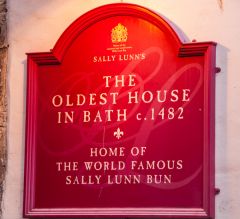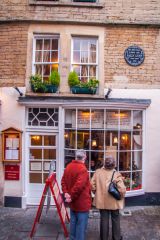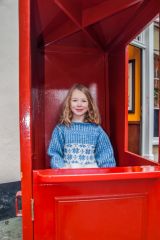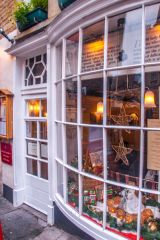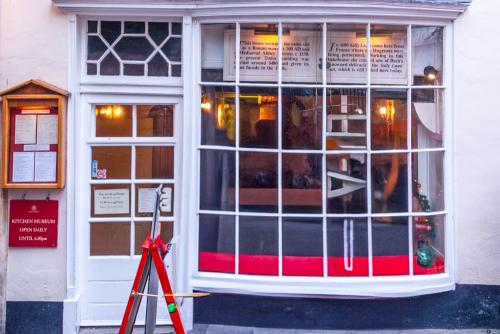
Sally Lunn's Bakery occupies one of the oldest houses in Bath. The Bakery is home to one of Bath's most famous products - the Bath Bun. Sally Lunn's bakery, teashop, and museum stand on foundations that date back to the Roman period. Take a tour of the cellars and see the original kitchens where the first Bath Bun was baked.
About Sally Lunn
In 1680 a young French Huguenot refugee named Solange Luyon arrived in Bath, and found employment with a baker in Lilliput Alley, near the Abbey. It was here that she began to bake the bun that became famous across Britain as the Bath Bun, or Sally Lunn Bun.
Though many attempts to recreate the original Bath Bun have been made, the recipe is a closely guarded secret, handed down with the lease to the bakery property that still stands in Lilliput Alley (later renamed North Parade Passage).
Bath Buns
The original 'Bath Bun' baked by Sally Lunn was a light, round bread similar to traditional French festival breads. The popularity of the Bath Buns was such that they were mass-produced for the Great Exhibition of 1851 in London - creating a more sugary, lower quality bun known as the 'London Bath Bun'. These 'London' versions of the Bath Bun are only a pale shadow of the real thing! For a real taste treat, get an authentic Bath Bun baked to the original recipe from the teashop at Sally Lunn's.
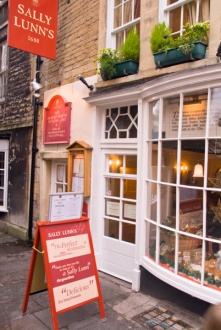
The House
Sally Lunn's stands on Roman foundations. Excavations at the deepest level of the cellars have uncovered remains of a Roman hypocaust, mosaic tiles, painted plaster, and pottery. Discovery of a mortar vessel suggests strongly that food was prepared here during the Roman period; given the location close to the Roman baths it is quite possible that an inn stood on this site, serving visitors to the temple of Sulis Minerva.
Long after the departure of the Romans a great Benedictine monastery was built here, near the abbey, and in the north cellar of Sally Lunn's you can see foundation walls of the 12th-century refectory and kitchen of the monastery. Seven separate floor levels have been unearthed, covering the 12th to the 14th centuries.
Remains of a faggot oven have been discovered, used for baking bread. Sometime around 1482 new chimneys and a fireplace were built, and it is this 15th-century date with is usually assigned to the building.
The property was sold after the monastery was disbanded by Henry VIII, and in 1622 George Parker, a carpenter, built the present timber-framed house on the site of the former monastic buildings.
The house has changed very little since the 17th century, making it a vivid reminder of what Bath must have been like before the grand Palladian architecture swept away earlier medieval buildings.
Sally Lunn's is usually open daily except for Christmas.
About Sally Lunn's House
Address: 4 North Parade Passage,
Bath,
Somerset,
England, BA1 1NX
Attraction Type: Museum
Location: On North Parade Passage, just around the corner from Bath Abbey
Website: Sally Lunn's House
Location
map
OS: ST751646
Photo Credit: David Ross and Britain Express
HERITAGE
 We've 'tagged' this attraction information to help you find related historic attractions and learn more about major time periods mentioned.
We've 'tagged' this attraction information to help you find related historic attractions and learn more about major time periods mentioned.
Historic Time Periods:
Find other attractions tagged with:
12th century (Time Period) - 15th century (Time Period) - 17th century (Time Period) - Henry VIII (Person) - Medieval (Time Period) - Palladian (Architecture) - Roman (Time Period) -
NEARBY HISTORIC ATTRACTIONS
Heritage Rated from 1- 5 (low to exceptional) on historic interest
Bath Abbey - 0 miles (Historic Church) ![]()
The Roman Baths - 0.1 miles (Roman Site) ![]()
Victoria Art Gallery - 0.1 miles (Museum) ![]()
Bath Postal Museum - 0.2 miles (Museum) ![]()
William Herschel Museum - 0.3 miles (Museum) ![]()
Jane Austen Centre - 0.3 miles (Museum) ![]()
Bath Assembly Rooms - 0.4 miles (Historic Building) ![]()
Fashion Museum, Bath - 0.4 miles (Museum) ![]()
